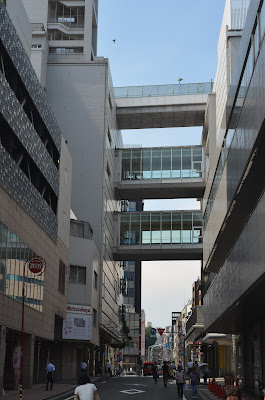søndag 30. september 2012
Tokyo movie
Tokyo movie, an introduction and documentation of Tokyo seen from my eyes, will soon be uploaded. Stay tuned.
fredag 28. september 2012
Yotsuya, Shinjuku-ku
 |
| How does a potenial new floor filter people from the busy main street to the small, quiet side streets? |
Hokosha Tengoku
Every Saturday or Sunday, the main streets in places like Ginza or Shinjuku are shut off for automobile traffic. This is called "Hokosha Tengoku", translating "Pedestrian Heaven".
mandag 17. september 2012
sketches
I am finally back in Norway, struggling to put together all of my experiences and process them. One way I deal with the reflection by myself is by post-processing sketches and illustrations. They show me some my clearest images where the hand and the mind is connected. I want to make a large collection of small images, as this is truly the image of Tokyo. Every sketch represents a unique situation and atmosphere. It is a very fragile, but delicate moment. Maybe after less than one minute I might have moved position, or the situation has changed, giving a completely new picture. But the memory lingers on, and continues to build upon my knowledge of the city. Liven knowledge.
Tomorrow I will have my first tutoring since my return, and I will hopefully choose my direction precisely after that. I am currently focusing on doing a project on the historical/cultural path that goes from Ueno through Asakusa and over Sumida river.
Tomorrow I will have my first tutoring since my return, and I will hopefully choose my direction precisely after that. I am currently focusing on doing a project on the historical/cultural path that goes from Ueno through Asakusa and over Sumida river.
mandag 10. september 2012
Small change
 |
| Here you have to use the stairs because this library wish to save electicity! |
 |
| Finally, the vendingmachines can sustain themselves. |
fredag 7. september 2012
Where will we live tomorrow?
 |
| Suzuko Yamada, 1:1 model |
Tokyo Metoropolitan Art Museum has an architecture exhibition called "Where will we live tomorrow", where 28 young architects present their interpretation of a dwelling for the future. Suzuko Yamada, a staff member from Sou Fujimoto Architect, exhibits an amazing 1:1 model of her concept dwelling.
Tomorrow I am going to Hamamatsu city in Shizouka Prefecture to meet up with the architects from the office called 403architecture [dajiba], one of the up-and-coming young offices that represents the next generation in Japan. They focus on reuse of materials, especially wood, to create new forms of spaces in urban settings. Check it out: http://www.403architecture.com/
torsdag 6. september 2012
Today I have been walking around in Yoyogi park, observing and interviewing different types of people about their relation to the park. I got help from Mai Matsuoka and Fujimoto Yuta to translate my questions. It was very interesting to get a little bit more understanding about the urban behaviour in a park like Yoyogi. People come here for many reasons, and travels from all sort of places. Some as short as only 10 minutes by walk, and other as far as Hokkaido in North Japan.
Here is a list of activities that I have observed in Yoyogi park:
Walking
SketchingWatercolor painting
Singing
Performing/acting
Choir practice
High school student PE-class
Eating lunch
Watching people
Resting and refreshing
JugglingArranging waterballoon competition
Play badminton
Outdoor kindergarden
Bicycling on the bike track
Jogging
Walking dogs and let them run loose at the dog-run park
Look at plants
Earthquake emergency zone supply
Give work to poor/homeless people (such as clean, fix park objects and watering plants)
Sleeping (homeless sleeping camp in the outskirts of the park)
Comedian act
Party (hanami/momiji)
Ritual performance
Use the toilet or changing rooms
Take photos of views and people
Play an instrument
Sightseeing
Philosophy reading
Discussion at a table
Meet friends that lives far away
Dating
Excercise martial art
Dance
Play in natural surroundings (with sticks, rocks..)
Light small fireworks
onsdag 5. september 2012
map for blind people
Today I found a station that had a very beautiful map for blind people. It was a relief telling about all the edges, steps and stairs on the station. Moving in a space with different levels can actually be a good experience for blind and visually impaired persons, as long as the right conditions are present.
tirsdag 4. september 2012
Historical and cultural path
This evening when I was looking for a firework festival, I accidentally stumbled upon a designated Tokyo Historical & Cultural Walk-route in Gokoji, north of Kagurazaka. Apparently there are 23 historical walks around Tokyo that takes you through main areas and historically important streets. There was a map that showed places of interest, such as parks, temples, shrines, toilet facilities and so on. I did not have time to walk the path I found. (It said it takes 1 1/2 hour to walk, but I guess it would have been much faster on a bicycle). However, I will try to find more information about these routes, but my first try at google didn't give so many clues. I think it looks similar to the Norwegian National Tourist Roads, on an urban scale, and it might be interesting for my project.
mandag 3. september 2012
plants
Potted plants are a common sight and an important contribution to make Tokyo a green city. Beacuse of the subdivision of plots and the exensive amount of single detatched houses, private potted plant are a common view in the streets. So if every house exploits 0,5-1m of their scarce space outside of their 50-100sqm footprint house, there will be 8,5-17sqm green space pr. house. Imagine how much parkspace 100 houses would produce.
Abonner på:
Innlegg (Atom)
























